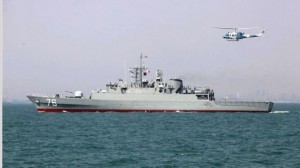 Iranian Navy Commander Rear Admiral Habibollah Sayyari has announced that an indigenous destroyer and a new naval minesweeping system will join the Islamic Republic�s naval fleet �in the near future.�
Iranian Navy Commander Rear Admiral Habibollah Sayyari has announced that an indigenous destroyer and a new naval minesweeping system will join the Islamic Republic�s naval fleet �in the near future.�Speaking to reporters on Thursday, Sayyari characterized Shaheed Bayandor destroyer as one that has been designed based on �state-of-the-art technological systems.�
In recent years, Iran has made great achievements in its defense sector and attained self-sufficiency in producing essential military equipment and systems.
Iran's Navy launched the Jamaran 2 destroyer in the Caspian Sea on March 16, 2013. Jamaran 2, a Mowj-class warship, has been designed and built by Iranian experts and is equipped with high-tech navigational devices and complex defensive systems.
The Iranian Navy launched its first destroyer, Jamaran, in the waters of the Persian Gulf in February 2010. The 1,420-ton vessel comes with modern radar systems and other electronic warfare capabilities.
Sayyari said Iran�s naval forces are also currently working to launch a minesweeping system and noted that the deployment of the system would enable the country to immediately sweep any mines laid in port entrances.
�Iran�s Navy is currently a grand force and if the enemy seeks to make any disruptions to our [presence] in the seas and the route of our ships, we can confront it by our own equipment,� the Iranian naval commander pointed out.
He stated that the deployment of Iran�s naval forces in the Indian Ocean, the Gulf of Aden and the Red Sea has helped secure the region against pirate attacks.
The Iranian Navy has been conducting anti-piracy patrols in the Gulf of Aden since November 2008 to safeguard the vessels involved in maritime trade, especially the ships and oil tankers owned or leased by Iran.
The Gulf of Aden, which links the Indian Ocean with the Suez Canal and the Mediterranean Sea, is the quickest route for thousands of vessels traveling annually between Asia, Europe and the Americas.
However, attacks by heavily armed Somali pirates on speedboats have prompted some of the world's largest shipping firms to switch routes from the Suez Canal and reroute cargo vessels around southern Africa, leading to climbing shipping costs.
By Press TV
The Iran Project is not responsible for the content of quoted articles.










